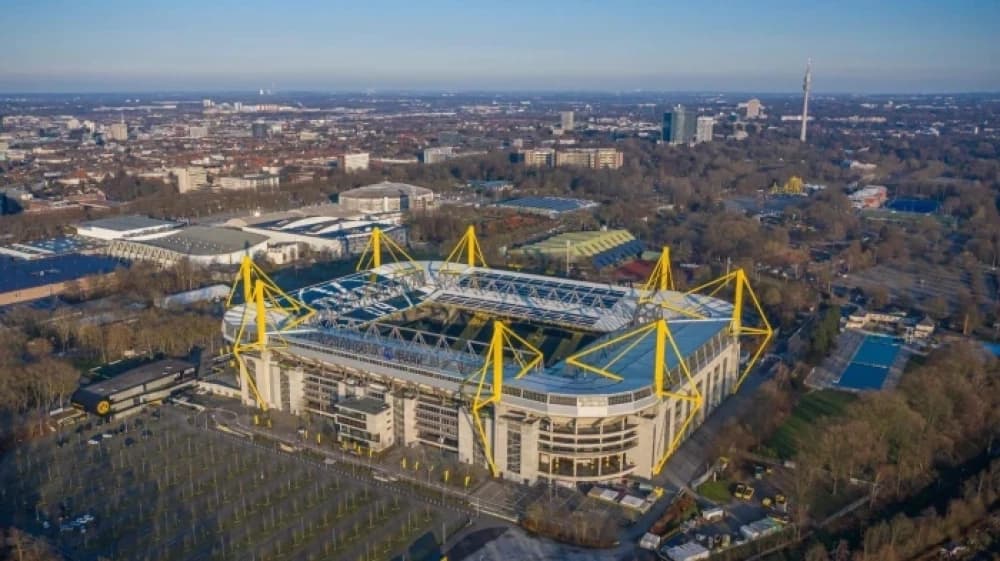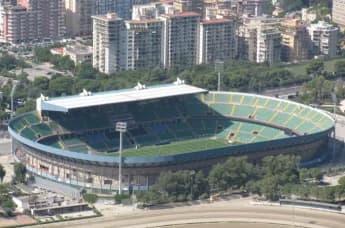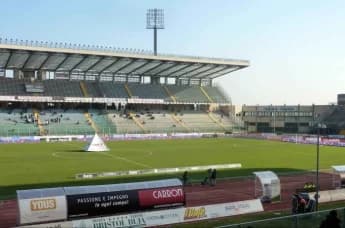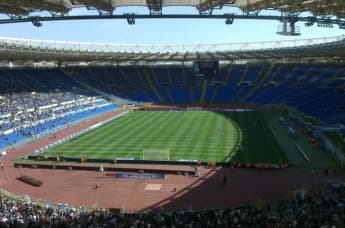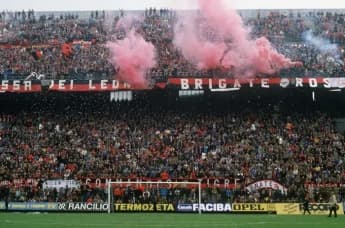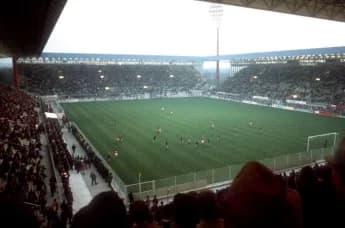Where History, Atmosphere, and Unwavering Fan Devotion Collide in Europe’s Most Iconic Football Stadium
Nestled in the vibrant city of Dortmund, Germany, Signal Iduna Park stands as a towering monument to football culture, embodying the spirit of Borussia Dortmund, one of the world’s most storied football clubs. Known affectionately as Westfalenstadion by locals and officially as Signal Iduna Park, this stadium transcends its role as a mere sports venue. It is an emotional fortress, a place where the thunderous roar of the iconic "Yellow Wall" reverberates through the stands, creating an atmosphere that is both electrifying and unforgettable. More than just a stadium, Signal Iduna Park is a pilgrimage site for football enthusiasts worldwide, drawing fans from every corner of the globe to witness its unparalleled energy and passion.
From the moment you step into Signal Iduna Park, you are enveloped by an undeniable sense of history, energy, and anticipation. The air crackles with excitement, whether it’s the spine-tingling buildup to a crucial Bundesliga clash or the electric charge of a European night under the floodlights. With a capacity of over 81,000, it ranks among the largest stadiums in Europe, yet it retains an intimate feel, a testament to the unity and unwavering support of Borussia Dortmund’s fans. This is not just a stadium; it is a living, breathing entity, a place where football is not just played but celebrated.
At the heart of Signal Iduna Park lies the legendary "Yellow Wall," the South Stand (Südtribüne), the largest terrace for standing spectators in European football. On match days, it transforms into a sea of yellow, a wave of noise, passion, and devotion that has become synonymous with Borussia Dortmund. When the crowd belts out the club’s anthem, "You’ll Never Walk Alone," the entire stadium seems to tremble with emotion. This collective spirit is palpable, reverberating through the stands and creating an experience that transcends the game itself.
Signal Iduna Park is more than just the backdrop for Borussia Dortmund’s home matches; it is a testament to the club’s identity, a stage where history is made and unforgettable moments are forged. From legendary performances to iconic goals and nights of European glory, the stadium has witnessed it all, cementing its place in football folklore. Yet, beyond the victories and records, it is the atmosphere that truly sets Signal Iduna Park apart. It is a model of what a football stadium should be: a cauldron of noise, a symphony of chants, and a place where fans and players are united in their love for the game.
Despite its deep historical roots, Signal Iduna Park has embraced modernity, undergoing numerous upgrades to enhance the fan experience and maintain its status as a world-class venue. State-of-the-art facilities, improved seating, and enhanced safety measures ensure that the stadium remains at the forefront of modern football while preserving its old-school charm and connection to its passionate fanbase. These innovations have solidified Signal Iduna Park’s reputation as one of the most atmospheric and revered stadiums in the world.
From the sheer scale of its stands to the heart-stopping moments that unfold on the pitch, Signal Iduna Park is a place where history is written with every match. For Borussia Dortmund and its fans, it is not just a stadium—it is home. A home where the love for the game knows no bounds, where every match is a celebration, and where every goal is a reason to roar.
Whether you are a lifelong supporter or a first-time visitor, stepping into Signal Iduna Park is an experience that stays with you long after the final whistle. It is not just about football; it is about the bond between fans, the city, and the beautiful game itself. This is Signal Iduna Park—the beating heart of Borussia Dortmund and one of the most iconic and atmospheric football venues in the world.
History and Construction: The Birth of a Footballing Colossus
The story of Signal Iduna Park begins long before its towering stands and electric atmosphere became legendary. To understand the significance of this footballing colossus, we must delve into the early history of Borussia Dortmund and the journey that led to the creation of a stadium that would become a global symbol of football passion.
The Foundation of Borussia Dortmund and the Need for a New Home
Founded in 1909, Borussia Dortmund rose from humble beginnings to become one of Germany’s most successful and beloved football clubs. However, as the team’s success grew, so did the need for a larger, more modern stadium. The club’s original home, Stadion Rote Erde, with its modest capacity and intimate atmosphere, had served them well for decades. But by the late 1980s, it was clear that the old stadium could no longer accommodate the growing number of fans or meet the evolving standards of modern football.
Borussia Dortmund’s vision was clear: they needed a new stadium that would not only meet the demands of the modern game but also strengthen the bond between the team and its ever-growing fanbase. The decision to build a new stadium was driven by the need for progress, innovation, and, most importantly, to create a place where the intense passion of their supporters could be fully realized.
The Planning Process: A Vision Comes to Life
The initial discussions about a new stadium began in the mid-1980s, with the club’s management keen to keep up with both domestic and international standards. However, the road to construction was fraught with challenges, including financing, land acquisition, environmental concerns, and the need to create a stadium that balanced functionality with fan experience.
In 1991, after years of planning, Borussia Dortmund moved forward with the project, forming a key partnership with the local government of Dortmund. A site near the heart of the city was chosen, and the blueprint for a modern football stadium emerged. The architectural firm HPP Hentrich-Petschnigg & Partner was tasked with designing a state-of-the-art structure that would capture the spirit of Borussia Dortmund while embracing modern innovations.
Construction Challenges and Setbacks
Construction began in 1992, but the project faced significant challenges, including financial difficulties and environmental regulations. Despite these hurdles, the stadium was completed in 1997, and on April 2 of that year, Signal Iduna Park (then known as Westfalenstadion) was officially opened. Borussia Dortmund marked the occasion with a 4-0 victory over 1860 Munich, setting the stage for the stadium’s legacy as a fortress of passion and pride.
Architectural and Design Features: A Modern Marvel
Signal Iduna Park is not just a football stadium; it is an architectural marvel that seamlessly blends modernity, fan culture, and functionality. Designed to accommodate Borussia Dortmund’s passionate fanbase, the stadium is a testament to the club’s identity and a symbol of footballing excellence.
The Yellow Wall: The Heart of Signal Iduna Park
The South Stand, or "Yellow Wall," is the stadium’s most iconic feature. With a capacity of over 25,000, it is the largest standing terrace in European football and the beating heart of Signal Iduna Park. The steep rake of the stand ensures that fans are close to the pitch, amplifying their voices and creating an atmosphere that is both intense and welcoming.
Sustainability and Technological Innovation
Signal Iduna Park is also a model of sustainability, incorporating energy-efficient lighting systems and exploring the use of solar panels to reduce its carbon footprint. The stadium’s design prioritizes fan comfort and safety, with state-of-the-art facilities and cutting-edge technology enhancing the matchday experience.
Atmosphere and Fan Experience: A Celebration of Football
The atmosphere at Signal Iduna Park is unparalleled, with the "Yellow Wall" leading the charge in creating an electric environment. The pre-match rituals, chants, and traditions of Borussia Dortmund’s fans add to the stadium’s unique charm, making every match a celebration of football.
The Cultural Connection
Signal Iduna Park is more than just a stadium; it is a cultural hub that reflects the deep connection between Borussia Dortmund and the city of Dortmund. The stadium’s influence extends beyond football, hosting concerts, rugby matches, and other events that showcase its versatility and significance.
Visiting Signal Iduna Park: A Pilgrimage for Football Fans
For any football fan, a visit to Signal Iduna Park is a must. From its convenient location and excellent transport links to its rich history and vibrant atmosphere, the stadium offers an unforgettable experience. Whether you’re attending a match, taking a stadium tour, or exploring the city of Dortmund, Signal Iduna Park promises memories that will last a lifetime.
Signal Iduna Park is not just a stadium; it is a symbol of footballing passion, a place where history is made, and a home for Borussia Dortmund’s devoted fans. It is a testament to the power of football to unite, inspire, and create moments of pure magic. This is Signal Iduna Park—the beating heart of Borussia Dortmund and one of the most iconic football venues in the world.
Nestled in the vibrant city of Dortmund, Germany, Signal Iduna Park stands as a towering monument to football culture, embodying the spirit of Borussia Dortmund, one of the world’s most storied football clubs. Known affectionately as Westfalenstadion by locals and officially as Signal Iduna Park, this stadium transcends its role as a mere sports venue. It is an emotional fortress, a place where the thunderous roar of the iconic "Yellow Wall" reverberates through the stands, creating an atmosphere that is both electrifying and unforgettable. More than just a stadium, Signal Iduna Park is a pilgrimage site for football enthusiasts worldwide, drawing fans from every corner of the globe to witness its unparalleled energy and passion.
From the moment you step into Signal Iduna Park, you are enveloped by an undeniable sense of history, energy, and anticipation. The air crackles with excitement, whether it’s the spine-tingling buildup to a crucial Bundesliga clash or the electric charge of a European night under the floodlights. With a capacity of over 81,000, it ranks among the largest stadiums in Europe, yet it retains an intimate feel, a testament to the unity and unwavering support of Borussia Dortmund’s fans. This is not just a stadium; it is a living, breathing entity, a place where football is not just played but celebrated.
At the heart of Signal Iduna Park lies the legendary "Yellow Wall," the South Stand (Südtribüne), the largest terrace for standing spectators in European football. On match days, it transforms into a sea of yellow, a wave of noise, passion, and devotion that has become synonymous with Borussia Dortmund. When the crowd belts out the club’s anthem, "You’ll Never Walk Alone," the entire stadium seems to tremble with emotion. This collective spirit is palpable, reverberating through the stands and creating an experience that transcends the game itself.
Signal Iduna Park is more than just the backdrop for Borussia Dortmund’s home matches; it is a testament to the club’s identity, a stage where history is made and unforgettable moments are forged. From legendary performances to iconic goals and nights of European glory, the stadium has witnessed it all, cementing its place in football folklore. Yet, beyond the victories and records, it is the atmosphere that truly sets Signal Iduna Park apart. It is a model of what a football stadium should be: a cauldron of noise, a symphony of chants, and a place where fans and players are united in their love for the game.
Despite its deep historical roots, Signal Iduna Park has embraced modernity, undergoing numerous upgrades to enhance the fan experience and maintain its status as a world-class venue. State-of-the-art facilities, improved seating, and enhanced safety measures ensure that the stadium remains at the forefront of modern football while preserving its old-school charm and connection to its passionate fanbase. These innovations have solidified Signal Iduna Park’s reputation as one of the most atmospheric and revered stadiums in the world.
From the sheer scale of its stands to the heart-stopping moments that unfold on the pitch, Signal Iduna Park is a place where history is written with every match. For Borussia Dortmund and its fans, it is not just a stadium—it is home. A home where the love for the game knows no bounds, where every match is a celebration, and where every goal is a reason to roar.
Whether you are a lifelong supporter or a first-time visitor, stepping into Signal Iduna Park is an experience that stays with you long after the final whistle. It is not just about football; it is about the bond between fans, the city, and the beautiful game itself. This is Signal Iduna Park—the beating heart of Borussia Dortmund and one of the most iconic and atmospheric football venues in the world.
History and Construction: The Birth of a Footballing Colossus
The story of Signal Iduna Park begins long before its towering stands and electric atmosphere became legendary. To understand the significance of this footballing colossus, we must delve into the early history of Borussia Dortmund and the journey that led to the creation of a stadium that would become a global symbol of football passion.
The Foundation of Borussia Dortmund and the Need for a New Home
Founded in 1909, Borussia Dortmund rose from humble beginnings to become one of Germany’s most successful and beloved football clubs. However, as the team’s success grew, so did the need for a larger, more modern stadium. The club’s original home, Stadion Rote Erde, with its modest capacity and intimate atmosphere, had served them well for decades. But by the late 1980s, it was clear that the old stadium could no longer accommodate the growing number of fans or meet the evolving standards of modern football.
Borussia Dortmund’s vision was clear: they needed a new stadium that would not only meet the demands of the modern game but also strengthen the bond between the team and its ever-growing fanbase. The decision to build a new stadium was driven by the need for progress, innovation, and, most importantly, to create a place where the intense passion of their supporters could be fully realized.
The Planning Process: A Vision Comes to Life
The initial discussions about a new stadium began in the mid-1980s, with the club’s management keen to keep up with both domestic and international standards. However, the road to construction was fraught with challenges, including financing, land acquisition, environmental concerns, and the need to create a stadium that balanced functionality with fan experience.
In 1991, after years of planning, Borussia Dortmund moved forward with the project, forming a key partnership with the local government of Dortmund. A site near the heart of the city was chosen, and the blueprint for a modern football stadium emerged. The architectural firm HPP Hentrich-Petschnigg & Partner was tasked with designing a state-of-the-art structure that would capture the spirit of Borussia Dortmund while embracing modern innovations.
Construction Challenges and Setbacks
Construction began in 1992, but the project faced significant challenges, including financial difficulties and environmental regulations. Despite these hurdles, the stadium was completed in 1997, and on April 2 of that year, Signal Iduna Park (then known as Westfalenstadion) was officially opened. Borussia Dortmund marked the occasion with a 4-0 victory over 1860 Munich, setting the stage for the stadium’s legacy as a fortress of passion and pride.
Architectural and Design Features: A Modern Marvel
Signal Iduna Park is not just a football stadium; it is an architectural marvel that seamlessly blends modernity, fan culture, and functionality. Designed to accommodate Borussia Dortmund’s passionate fanbase, the stadium is a testament to the club’s identity and a symbol of footballing excellence.
The Yellow Wall: The Heart of Signal Iduna Park
The South Stand, or "Yellow Wall," is the stadium’s most iconic feature. With a capacity of over 25,000, it is the largest standing terrace in European football and the beating heart of Signal Iduna Park. The steep rake of the stand ensures that fans are close to the pitch, amplifying their voices and creating an atmosphere that is both intense and welcoming.
Sustainability and Technological Innovation
Signal Iduna Park is also a model of sustainability, incorporating energy-efficient lighting systems and exploring the use of solar panels to reduce its carbon footprint. The stadium’s design prioritizes fan comfort and safety, with state-of-the-art facilities and cutting-edge technology enhancing the matchday experience.
Atmosphere and Fan Experience: A Celebration of Football
The atmosphere at Signal Iduna Park is unparalleled, with the "Yellow Wall" leading the charge in creating an electric environment. The pre-match rituals, chants, and traditions of Borussia Dortmund’s fans add to the stadium’s unique charm, making every match a celebration of football.
The Cultural Connection
Signal Iduna Park is more than just a stadium; it is a cultural hub that reflects the deep connection between Borussia Dortmund and the city of Dortmund. The stadium’s influence extends beyond football, hosting concerts, rugby matches, and other events that showcase its versatility and significance.
Visiting Signal Iduna Park: A Pilgrimage for Football Fans
For any football fan, a visit to Signal Iduna Park is a must. From its convenient location and excellent transport links to its rich history and vibrant atmosphere, the stadium offers an unforgettable experience. Whether you’re attending a match, taking a stadium tour, or exploring the city of Dortmund, Signal Iduna Park promises memories that will last a lifetime.
Signal Iduna Park is not just a stadium; it is a symbol of footballing passion, a place where history is made, and a home for Borussia Dortmund’s devoted fans. It is a testament to the power of football to unite, inspire, and create moments of pure magic. This is Signal Iduna Park—the beating heart of Borussia Dortmund and one of the most iconic football venues in the world.

